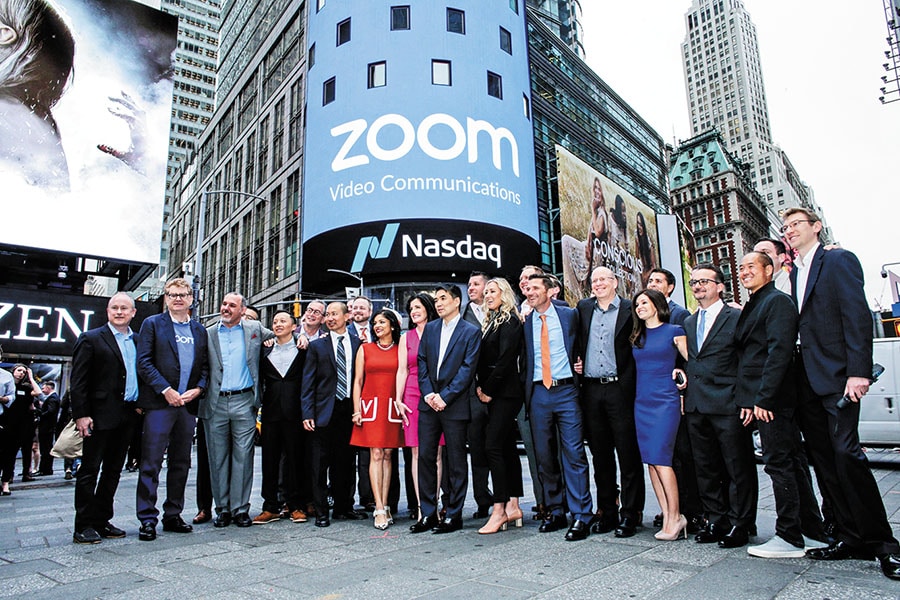
Zoom: Silicon Valley's sexiest IPO
Wall Street's hottest new stock isn't that of a social network or ride-hailing platform, but a video app that wins by just working better
 Founder Eric Yuan hopes that decades from now, employees will remember Zoom as a great place to work: “If they feel that way, I’ll feel like my dream came true.”
Founder Eric Yuan hopes that decades from now, employees will remember Zoom as a great place to work: “If they feel that way, I’ll feel like my dream came true.”Image: Ethan Pines for Forbes
Zoom CEO Eric Yuan cut an unlikely figure as he addressed the cheering throng in the moments before ringing the opening bell at Nasdaq, his bashful grin giving way to a look of focus as he said, “A new game starts today.” Sure, his startup wasn’t as well-known as Lyft and Pinterest, two consumer companies that also just made their IPO debuts. But to anyone familiar with Yuan, the shock wasn’t how he got there. It was that he was physically present at all.
The founder of Zoom, which provides videoconferencing software over the internet, practises what he preaches. After Yuan hired hundreds of engineers in his native China, he went three years between in-person visits. When he raised money from top venture capital investors, he showed up just once, to make sure every investor in the room had downloaded the Zoom app. For his IPO road show, Yuan deigned to make the 50-mile trek from his San Jose, California, headquarters to San Francisco for a single investor lunch—and then bolted back to work. Everyone else, money manager big or small, met with him virtually, over Zoom. When Yuan flew to New York for the IPO, it was just his eighth work trip in five years.
“Customers have always said, ‘Eric, we’ll become your important customer, you’ve got to visit us,’” says Yuan. “I say, ‘Fine, I’m going to visit you, but let’s have a Zoom call first.’” That’s usually enough.
It worked with Wall Street, where demand for Zoom (formally known as Zoom Video Communications) prompted the company to raise its IPO price to $36 per share, valuing the company at $9.2 billion—and making Yuan a billionaire at 49. The stock’s 72 percent first-day pop boosted Zoom’s market cap to $15.9 billion and the net worth of Yuan, who owns 20 percent, to $3.2 billion. All for videoconferencing tools that didn’t reinvent the wheel but made it a lot less painful to turn. An engineer turned founder who once ran engineering for Cisco’s Webex videoconferencing business, Yuan set out to make tools that work equally well in a boardroom in Manhattan and from a kitchen table in China. Built in the cloud and priced using a “freemium” model that let anyone host a meeting of 40 minutes or less for free, Zoom now posts numbers that had Aaron Levie, the CEO of Box (a customer), tweeting it could start a second business selling its “beautiful” financial numbers as a coffee-table book.
With annual revenue of $331 million, up 118 percent, and 50,000 corporate customers, including Samsung, Uber, Walmart and Capital One, Zoom was the ultra-rare tech unicorn that was profitable before it went public. Its sudden fame—emanating from its IPO—is a new feel for a company that takes its cues from a CEO who not only shuns the spotlight but is so frugal he insists on reimbursing the company when he gives a friend swag like a Zoom backpack. Beneath the belated buzz: A story of perseverance and better execution, proving that an unexpected challenger can sweep the field, even in a crowded market.
With hypergrowth comes risk, of course, and Zoom still must prove it can continue to best its competitors: Massive companies like Google and Microsoft that had scared off most venture investors during Zoom’s early days eight years ago. Cisco, Yuan’s former employer, may privately rue letting him leave, but it’s not shying away from a fight. And while Zoom has the goodwill of much of the tech community, its inevitable move beyond video means its list of competitors is likely to grow. Ringing the Nasdaq bell checks off one dream for Yuan. There are plenty more. “It’s like a marathon,” Yuan says, “You’re only 5 miles ahead of me, that’s okay. I’ll run faster, and catch up.”
(This story appears in the 30 November, -0001 issue of Forbes India. To visit our Archives, click here.)
 Zoom management waves at employees tuning into Times Square on the morning of its April IPO
Zoom management waves at employees tuning into Times Square on the morning of its April IPO



